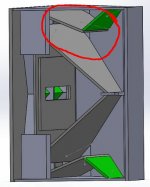I lived with a Klipschorn bass for 45 years until downsizing not long ago. Granted, doesn't go low by today's expectations, but never heard better bass, filling the room with great waves of very clean bass. Any way to say that in terms of our familiar measurements or simulation parameters?
Great man. Had some correspondence with him long ago. Don't forget, his construction during a time of wood restraint was set at 4 x 8 plywood sheets.
Footnote: his plywood is not very thick, even for the sealed compartment. Probably smart. I used quarter-inch plywood on my recent labyrinth and measured results seem to be fine.
B.
Great man. Had some correspondence with him long ago. Don't forget, his construction during a time of wood restraint was set at 4 x 8 plywood sheets.
Footnote: his plywood is not very thick, even for the sealed compartment. Probably smart. I used quarter-inch plywood on my recent labyrinth and measured results seem to be fine.
B.
Hi whgeiger,
Thanks for the drawings. I looked at all three sheets, and did not see a cross sectional view that shows the expansion from the side view after the signal makes the bend at the top and bottom of the front panel. See the attachment for the area in question.
The overall design looks very similar to the Klipsch though.
Jim.
Thanks for the drawings. I looked at all three sheets, and did not see a cross sectional view that shows the expansion from the side view after the signal makes the bend at the top and bottom of the front panel. See the attachment for the area in question.
The overall design looks very similar to the Klipsch though.
Jim.
Attachments
Last edited:
K-horn Improvements
Hi,
It seems that the standard K-horn flare rate can be improved by the flare changes presented here. The changes made were based on DM's original K-33 parameters, which were modeled with HR in the first post.
I have not done an exhaustive modeling analysis, but did find that removing the rubber throat and going with a long section of conical flare, and ending with an exponential flare does flatten the low end and remove the high end droop of the standard Klipsch flare.
Note that the rear chamber volume has been reduced from 81L to 50L in this example.
It would be interesting to hear if others have tried other acoustic channel shapes to improve the stock flares. 🙂
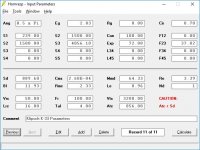
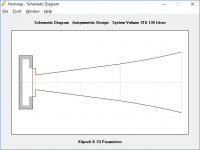
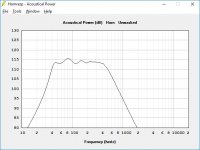
Jim.
Hi,
It seems that the standard K-horn flare rate can be improved by the flare changes presented here. The changes made were based on DM's original K-33 parameters, which were modeled with HR in the first post.
I have not done an exhaustive modeling analysis, but did find that removing the rubber throat and going with a long section of conical flare, and ending with an exponential flare does flatten the low end and remove the high end droop of the standard Klipsch flare.
Note that the rear chamber volume has been reduced from 81L to 50L in this example.
It would be interesting to hear if others have tried other acoustic channel shapes to improve the stock flares. 🙂



Jim.
Last edited:
... Any way to say that in terms of our familiar measurements or simulation parameters?.....
Hi bentoronto,
I had wondered about this for some time, and my take is that once the diaphragm excursion goes beyond a certain point, the bass starts to get muddy sounding.
Richard Heyser did a full analysis of the K-horn back in the 1970's (sorry I do not have the exact date). He recorded the sound of a car being slammed shut, then played back the sound on two speaker systems. The first was a full spectrum system, which included a sub, and the second was the K-horn. The sound from the sub produced a muffled "whump" sound, while the K-horn produced a more realistic sounding car door slam.
So there seems to be something about the larger surface area that makes more realistic bass.
Jim.
Hi,
It seems that the standard K-horn flare rate can be improved by the flare changes presented here.
Greets!
No clue what the original's driver's specs were, but the design would have been based on factoring in the [matching] high output [multiple] impedance taps [low damping factor/DF] and variable DF tone controls of contemporary tube amps with driver specs changing over time to ameliorate this mismatch as much as practical to maintain its performance as amp DF rose over time and became so low with SS amps that only any XO components, speaker wiring losses might need to be accounted for, so little wonder it can be 'improved' at this late date to best match the current driver's specs.
Regardless, nice work, thanks for sharing and now with the availability of relatively inexpensive digital time delay, a viable high SQ bass corner horn option for the more intense/patient DIYers.
GM
Pat IV is a Scaled Klipsch Design
to accommodate an 18" driver.
In Part 2, item 10, green shaded in your drawing, is shown in assembly sketch below Item 10 & 11 details. It has a span of 7-1/8" and is inclined at a 40° angle. WHG
to accommodate an 18" driver.
Hi whgeiger,
Thanks for the drawings. I looked at all three sheets, and did not see a cross sectional view that shows the expansion from the side view after the signal makes the bend at the top and bottom of the front panel. See the attachment for the area in question.
The overall design looks very similar to the Klipsch though.
Jim.
In Part 2, item 10, green shaded in your drawing, is shown in assembly sketch below Item 10 & 11 details. It has a span of 7-1/8" and is inclined at a 40° angle. WHG
but never heard better bass, filling the room with great waves of very clean bass. Any way to say that in terms of our familiar measurements or simulation parameters?
Parameter = diaphragm displacement.
For a given SPL, the driver diaphragm displacement of a well-designed horn system will be significantly less than that of a direct radiator, due to the higher acoustical impedance loading the diaphragm of the horn system. Amplitude modulation distortion and frequency modulation distortion are both directly proportional to diaphragm displacement.
Last edited:
What you are saying in other words is, "It's a horn!".Parameter = diaphragm displacement.
For a given SPL, the driver diaphragm displacement of a well-designed horn system will be significantly less than that of a direct radiator, due to the higher acoustical impedance loading the diaphragm of the horn system. Amplitude modulation distortion and frequency modulation distortion are both directly proportional to diaphragm displacement.
My point is that the parameters of the phenomenological experience (call it "big room-filling waves of clean sound") is the parameter that is hard to characterize, not the imputed cause of the hard to measure experience. I'm not saying that a wise person couldn't use REW in a way that would let them fine-tune a room with a corner horn.... maybe.
And I would respectfully disagree with your view that the wonderful sound arises from slightly reduced driver distortion since you can have a bunch of BR boxes and the sound is still not a happy experience for many of us.
While the thoughts of those concerned about sims and modelling readily turn to distortion and cone excursion, those of us interested in motional feedback might think that a far more important quality of a true horn is impact and transient behaviour. And I'll go with that.
I don't know if he was the first, but Klipsch keenly promoted his low Doppler, as you comment too. Some debate today about the importance and can't be a big issue with modern lower DSP crossover points.
B.
Last edited:
I used to have some dims and drawings for Ben Drisko's corner horn - It may have had different flare rates than K-horn IIRC (?)
PWK was a wizard with a handsaw to make such a marvel.
both the K-horn and Classic have almost the same exact back chamber volume.
hornresp says the Classic is working harder at 50Hz.
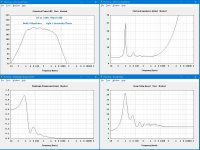
here's how my right K-horn measured (type A network - battery biased with KBG caps) - what specifically was the mic seeing at 138Hz for the floor plane and poked in the mouth - at floor traces ?
IIRC, there used to be pictures of listeners sitting on the floor listening to their K-horn. The mic on floor and back 8 feet response looked pretty good for that position.
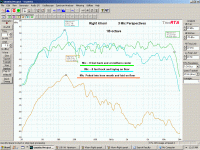
PWK was a wizard with a handsaw to make such a marvel.
both the K-horn and Classic have almost the same exact back chamber volume.
hornresp says the Classic is working harder at 50Hz.

here's how my right K-horn measured (type A network - battery biased with KBG caps) - what specifically was the mic seeing at 138Hz for the floor plane and poked in the mouth - at floor traces ?
IIRC, there used to be pictures of listeners sitting on the floor listening to their K-horn. The mic on floor and back 8 feet response looked pretty good for that position.

Last edited:
....And I would respectfully disagree with your view that the wonderful sound arises from slightly reduced driver distortion since you can have a bunch of BR boxes and the sound is still not a happy experience for many of us....
Very interesting comment! So it appears that, not only is surface area important at low frequencies, but also, the control of the woofer needs to be taken care of as well. And we know that a "tuned" cabinet relies on efficiency gain due to acoustic resonance.
Of the course the corner horn also relies on resonance to extend the low end frequency response, but apparently this is less of a listening distraction than the same tuning in a bass reflex.
I am not an expert at this, but seems to be what you are saying, if I follow you correctly.
Jim.
....here's how my right K-horn measured (type A network - battery biased with KBG caps) - what specifically was the mic seeing
at 138Hz for the floor plane and poked in the mouth - at floor traces ?....
Looking at your frequency response measurements, there seems to be a room resonance close to 130Hz. When the mike was placed on the floor, the peak occurred, and this was the case where the mike was close to the horn mouth, or further away. Not sure the cause.
Jim.
Very interesting comment! So it appears that, not only is surface area important at low frequencies, but also, the control of the woofer needs to be taken care of as well. And we know that a "tuned" cabinet relies on efficiency gain due to acoustic resonance.
The last thing you'd want in a HiFi is any resonance anywhere around. OK in a musical instrument but crap in music reproduction.
For speakers, the key issue is: light air being driven by a VASTLY heavier cone assembly. There's no easy way (except for motional feedback) to control the cone when it is playing into nothingness**. Ordinary drivers depend on their mechanical suspensions to supply roughly linear-like restoring forces and some degenerative feedback. Do you think that bit of rubber around the cone is real linear?
A true horn* is a transformer which you might say takes light air and condenses it against the horn cone driver. That way the driver is pushing against something heavier.
But to get the transformer effect at low frequencies requires a very large construction.
B.
* which never includes the deceptively-named tapped horn
** or you could use a very thin film of mylar for a driver as with electrostats
North Reading published a notch filter for the Klipschorn bass section - here's the response without and with that filter. (I tried similar but subjective results weren't improved as my walls resonate badly and for a long time - even a harpsichord recording will set my walls into a booommmmmm)
North Reading's K-horn graph
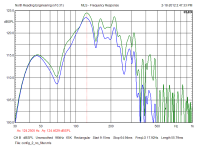
notch filter
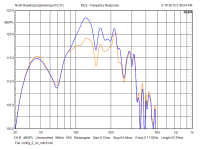
vs my crude in-room graph
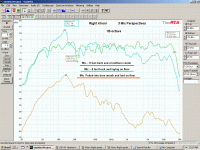
North Reading's K-horn graph

notch filter

vs my crude in-room graph

And I would respectfully disagree with your view that the wonderful sound arises from slightly reduced driver distortion
We are not talking about slightly reduced distortion here. To quote your "great man":
"...the cone motion for a given output is reduced to a small fraction of that required in a small-box speaker. The term "undistorted output" is sometimes used. Personally, I try to avoid the term. If a cone moves, it produces distortion, so I prefer to use the term "minimum" distortion as applied to horn speakers. Actually the distortion may be reduced by a factor of 1/10 or even 1/100 by the use of horns."
With specific reference to the mid-frequencies:
"...Distortion in this range can mask the sounds by which one distinguishes, for example, "key" from "tea".
~ Wireless World, February 1970, "Loudspeaker Performance - A discussion of power output and distortion levels for direct-radiator and horn loaded loudspeakers", Paul W. Klipsch.
If the clean bass of your Klipschorns was not due to low levels of distortion, what do you suggest was the reason?
Don't you think the acoustic low pass of front loading cone helps too from this point of view to reduce higher order harmonics ?
Last edited:
...
If the clean bass of your Klipschorns was not due to low levels of distortion, what do you suggest was the reason?
As you well know, within the Klipschorn bass passband and within domestic playback levels, distortion is not much of an issue absolutely or relative to other subs. But it can help.*
I don't have an evidence-based answer to your question or thoughts beyond my earlier guesses. It is possible the way a large horn mouth interacts with a room is also beneficial. Or the way a big horn (with cinderblock weights on top, ahem, ahem) creates a stable sound origin.
B.
*there is additional "filtering" of distortion products and noise in a horn due to the serpentine path. That cleans up the sound too. I experimented with absorbent but in the days before good measurement was available to me.
As you well know, within the Klipschorn bass passband and within domestic playback levels, distortion is not much of an issue absolutely or relative to other subs. But it can help.*
Except a compression horn's impulse response's lack of 'ringing' compared to even a transient perfect sealed 0.5 Qtc, which combined with its pass band's nominally flat phase and frequency response required to accurately reproduce a square wave and much larger acoustic coupling to the room to keep other mechanically induced distortions down in a typical room's noise floor, little wonder it can sound 'life-like' over a wide range even in an acoustically small room.
In short, I've long since concluded that for me it's the compression horn's and somewhat over-damped point source cab alignment's 'heart attack fast' transient response that is the 'key' to going 'Is it live or is it Memorex' in a typical room.
GM
I've got EV Sentry IV, Peavey FH1, a couple of custom FLH (both "midbass") and 3-K-horn (one not in service - no space - lol). Although it cuts off pretty high, I think Ray Newman's Sentry horn is pretty good but not played with it for years. (I used to have a drawing of his little bifurcated midbass horn whose cabinet shape matched that of the "Great White" horns)
fwiw I still have fun with the crazy Ks - the K18 below had an EVM18B (~65g mms) for that graph. Its better in ways than some horns its bulk - but does not "go low" - but it does rattle out to 4K - on axis 😀 The reflector is curved. Subjective cone motion seems very small.
Wolf von Langa who appeared enthusiastic over K-tubes (and K) I believe, has given up on K. I think he figures they would be difficult to market. The slotted pipe sounds "good enough" when mounted "in" the front chamber. A baffle at the compression driver's exit plane if a tube is used on the top might help on the tweeter's low end.
fwiw I still have fun with the crazy Ks - the K18 below had an EVM18B (~65g mms) for that graph. Its better in ways than some horns its bulk - but does not "go low" - but it does rattle out to 4K - on axis 😀 The reflector is curved. Subjective cone motion seems very small.
Wolf von Langa who appeared enthusiastic over K-tubes (and K) I believe, has given up on K. I think he figures they would be difficult to market. The slotted pipe sounds "good enough" when mounted "in" the front chamber. A baffle at the compression driver's exit plane if a tube is used on the top might help on the tweeter's low end.
Attachments
Last edited:
I built a copy 25 years ago. Using it in a bar.
Used it with a Beyma 15g400 with different amplifiers from100-500W. A few years ago I had to glue the cone of the old beyma because it was torn in pieces. Now I have a new B&C 15NA100 to replace the Beyma. With a capable amplifier HR predicts around 140dB.
As the horn was designed power levels where much lower, nowadays 1kW ist nothing. Can the Klipsch Horn handle that much output or is there a limit due to compression or "overloading" the speaker and destroying the cone?
Used it with a Beyma 15g400 with different amplifiers from100-500W. A few years ago I had to glue the cone of the old beyma because it was torn in pieces. Now I have a new B&C 15NA100 to replace the Beyma. With a capable amplifier HR predicts around 140dB.
As the horn was designed power levels where much lower, nowadays 1kW ist nothing. Can the Klipsch Horn handle that much output or is there a limit due to compression or "overloading" the speaker and destroying the cone?
- Status
- Not open for further replies.
- Home
- Loudspeakers
- Subwoofers
- Klipsch Bass Horn Acoustic Analysis
